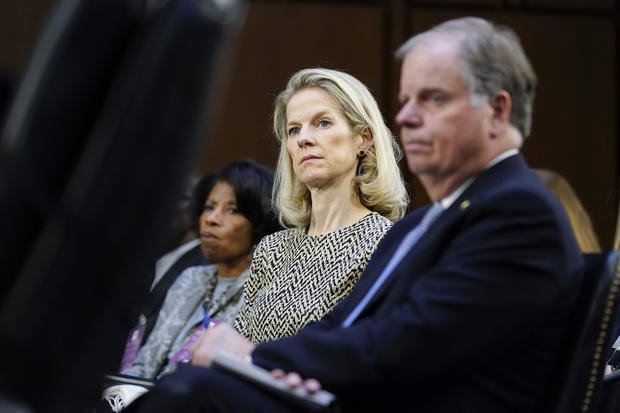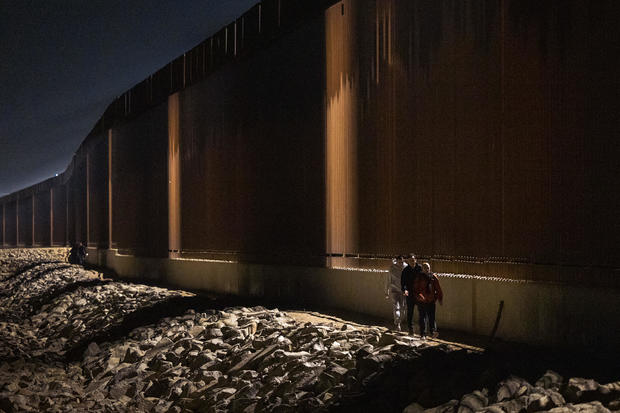Washington — As the number of migrants entering U.S. border custody was spiking in July 2021, posing major operational and political challenges for President Biden’s still-young administration, high-ranking officials proposed a drastic measure: making most recent arrivals ineligible for asylum.
The proposal entailed disqualifying migrants from asylum if they entered the U.S. between official ports of entry after failing to seek refuge in other countries, a move at odds with the promises Mr. Biden had made just a year prior to expand access to the U.S. asylum system after years of restrictions under former President Donald Trump.
The sweeping asylum restriction was proposed at a high level at the White House that summer as one of several policy options to curtail illegal border crossings, four former senior U.S. officials told CBS News, requesting anonymity to discuss internal deliberations.
But the administration did not move forward with the plan at the time amid opposition from some appointees. Dana Remus, then the White House counsel, warned it could be struck down as illegal, just like federal courts had found that similar Trump administration rules violated U.S. asylum law, the officials said.
Remus, one of the officials said, cautioned that moving forward with the proposal would involve a “high litigation risk” and that the administration would need to sufficiently distinguish its policy from the Trump administration’s asylum bans for it to withstand legal scrutiny.
While some appointees said the restriction would deter unlawful migration and help the administration manage the intensifying crisis along the southern border, other administration officials argued such a move would be illegal, trample on the rights of migrants and violate Mr. Biden’s campaign promises.
Andrew Harnik / AP
U.S. law gives migrants on American soil the right to request asylum, regardless of how they entered the country. To qualify for asylum, migrants must prove they are fleeing persecution based on their race, nationality, religion, political views or membership in a social group — a high legal threshold.
The disagreements over the asylum restriction — and the concerns about its legality — were part of broader rifts within the Biden administration between more progressive appointees who opposed restricting asylum and officials who believed restrictive measures were needed to deter unlawful border crossings.
“There were very divided policy reactions,” a senior Biden appointee told CBS News.
Officials in 2021 also clashed over proposals to expel older unaccompanied teenagers amid record arrivals of migrant children; convince Mexico to take back rejected asylum-seekers under a “safe third country” agreement; and resurrecting a version of a Trump administration policy that required migrants to await their asylum hearings in Mexico.
The push to restrict asylum continued within the administration as migrant apprehensions along the southern border hit record levels. Last week, the administration published a version of the asylum restriction, arguing that it is needed to prevent a massive spike in border arrivals once U.S. officials can no longer expel migrants under a pandemic-related migration restriction known as Title 42.
The proposed rule, which would bar migrants from requesting asylum if they enter the country illegally after failing to request refuge in a third country, would in practice allow the government to quickly deport most non-Mexicans and banish them from the U.S. for five years.
After a preliminary 30-day review process open to public comments, officials plan to implement the rule on or before May 11, when the expiration of the COVID-19 public health emergency is set to trigger Title 42’s end. The asylum restriction would remain in place for at least two years, with the option to extend it.
The proposed regulation has garnered intense criticism from immigrant rights advocates and many Democratic lawmakers, who say it violates Mr. Biden’s promises to overturn his predecessor’s border policies and expand protections for asylum-seekers fleeing violence. It has also received some rare Republican backing.
The American Civil Liberties Union (ACLU) has already vowed to file a lawsuit against the regulation once it is finalized. “The proposed rule is unlawful for the same core reason as the Trump bans: it violates the asylum laws enacted by Congress,” Lee Gelernt, the ACLU’s lead immigration lawyer, told CBS News.
Luis Miranda, a spokesperson for the Department of Homeland Security, said the administration “is confident in the legal authority to implement this rule.”
Current senior administration officials have conceded the asylum restriction was not their first or second “preference” to deal with migration. But they’ve argued the policy is an emergency measure that is needed amid historic levels of migration in the Western Hemisphere. Without it, they have projected, migrant arrivals along the southern border could spike to 13,000 per day when Title 42 lapses.
Top Biden administration officials have also denied that their proposed asylum restriction resembles Trump administration efforts to severely limit asylum eligibility, saying the policy includes broader humanitarian exemptions, including for unaccompanied children and asylum-seekers in imminent danger.
Qian Weizhong/VCG via Getty Images
Officials have also noted that the Biden administration, unlike the Trump administration, is simultaneously expanding opportunities for migrants to enter the U.S. legally. By barring most asylum cases in between the ports of entry, officials have argued, migrants will be encouraged to apply for these legal systems.
The administration has committed to allowing up to 30,000 migrants from Cuba, Haiti, Nicaragua, and Venezuela to enter the U.S. legally each month if they have U.S. sponsors. It is also permitting roughly 20,000 vulnerable migrants in Mexico to request entry at ports of entry through a mobile app on a monthly basis.
In the text of the proposed asylum restriction, the administration sought to distinguish its plan with Trump administration rules that barred migrants from requesting asylum if they crossed the border in between ports of entry or failed to seek refuge in third countries, both of which were declared unlawful by federal courts.
Its proposed policy, the Biden administration argued in its 153-page rule, is “more limited and less categorical” than the Trump asylum bans.
Privately, some Biden appointees acknowledged that the proposed rule is a far-reaching restriction that goes against the detailed promises Mr. Biden made to “restore our asylum laws” during the 2020 campaign. After all, Mr. Biden forcefully noted during one of the debates with Mr. Trump that his rival was “the first president in the history of the United States” to decree that “anybody seeking asylum has to do it in another country.”
Asked by CBS News on Wednesday whether the proposed rule goes against Mr. Biden’s promises to restore asylum, Homeland Security Secretary Alejandro Mayorkas said, “I don’t think so.”
“I think that this rule does not infringe on the jewel that is our asylum system. I believe very strongly in it,” Mayorkas said, noting the department will use comments from the public to “shape” the final regulation.
Other appointees disagree on whether the shift is justified, given the unprecedented levels of migrant apprehensions recorded in 2021 and 2022 and the political pressure over the issue from traditional Republican critics, as well as Democratic leaders in cities and states receiving migrants.
“From my sense, everything changed when Democratic mayors started saying ‘this is bad,’ because it was no longer just [Texas Gov. Greg] Abbott or just right-wing Republican governors complaining, people that you could write off as politically motivated,” one former official said.
Another appointee said the regulation is a poor policy move, even if it reduces the number of migrants coming to the southern border.
“It’s illegal. To me, it doesn’t even matter if it works or not. That’s not really the question because we can’t do things that are illegal,” the appointee said.
Alida Garcia, who worked at the White House as a senior adviser for migration in 2021, said the administration made a “fundamental error” early on by relying on Title 42 to manage migration without sufficiently focusing on building migrant processing capacity along the U.S.-Mexico border.
“It was always going to be hard to revert back to being lawful and adhering to people’s rights under U.S. and international law,” said Alida, who now oversees advocacy at FWD.us, a liberal lobbying group. “The lowest common denominator prevailed, because it’s the easiest, which is kicking the can on Title 42.”


